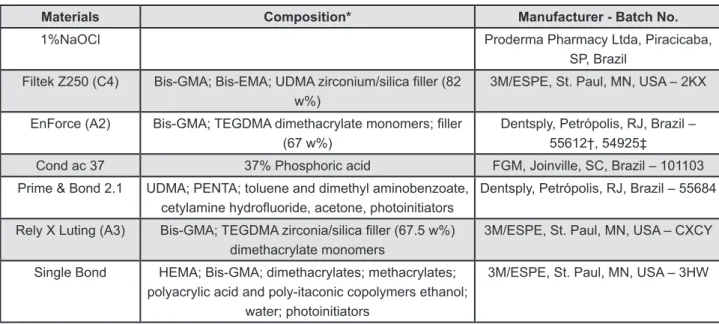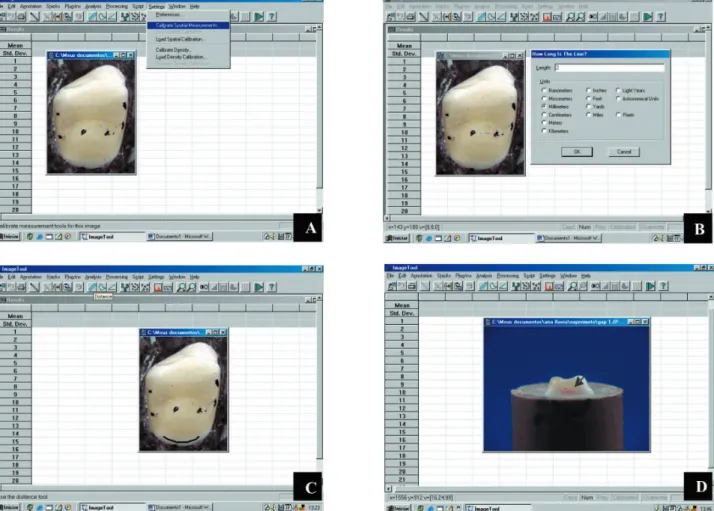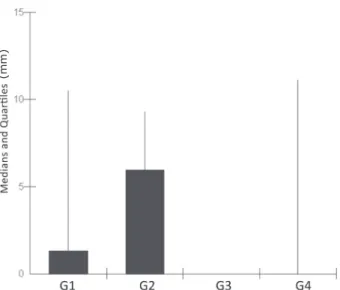ABSTRACT
Effects of resin luting agents and 1% NaOCl on
in primary teeth
Ana Flávia Sanches BORGES1, Luciana Estevam SIMONATO2, Fernanda Miori PASCON3, Kamila Rosamiglia KANTOWITZ3, Regina Maria Puppin RONTANI4
1- DDS, MS, PhD, Assistant Professor of Dental Materials, Department of Operative Dentistry, Endodontics and Dental Materials, Bauru School of Dentistry, University of São Paulo, Bauru, SP, Brazil.
2- DDS, MS Professor, Camilo Castelo Branco University, Fernandópolis, SP, Brazil.
3- DDS, MS Pediatric Dentistry Doctoral Degree Program, Piracicaba Dental School University of Campinas, Piracicaba, SP, Brazil. 4- DDS, MS, PhD Professor of Pediatric Dentistry, Piracicaba Dental School, University of Campinas, Piracicaba, SP, Brazil.
Corresponding address: Regina Maria Puppin Rontani - Faculdade de Odontologia de Piracicaba - UNICAMP - Avenida Limeira, 901, Areião - Piracicaba - SP - Brasil - 13414-903 - Phone: +55-19-2106-5286 - e-mail address: rmpuppin@fop.unicamp.br
!"#
O
!"# # $ &&'( )* +,#-!" irrigation+EnForce); G2 (EnForce); G3 (1% NaOCl irrigation+Rely X); G4 (Rely X). The 678,$9 :< ,,=>?"7* @A($"B<8 $ D$ ( H =$,$ submitted to a Kruskal-Wallis test (D=0.05). The Relative Risk test analyzed the chance of
$P Q,$,8# $D $"!" treatment nor the resin luting agents caused any alterations in the dental substrate that A $
Key words:"$S $@$
INTRODUCTION
Gap measurement is a reliable method of evaluating the initial quality of resin restorations1.
The presence of an enamel gap is an important factor that predicts future failures in composite restorations, and this occurs because of the composite resin polymerization shrinkage. Shrinkage
16. Even
:( minimal polymerization shrinkage due to cement agents, experience this phenomenon23.
It is extremely important to recognize enamel gap. As the normal stresses at the tooth/composite interface of a restoration increases from the enamel
13, it can
lead to discoloration, microleakage and secondary caries31.The feature of a linearly measured gap
seems to be a lack of adhesion. Alonso, et al.2
(2004) detected marginal gaps in the dentin/resin interface using a stain composed of red acid and propylene glycol (Caries Detector®). The detected
microscopy analysis of the same gaps1.
H ^ D vital ones, especially because there is a reduction of the inner cuspal slopes that support the cuspal angles of the coronal tooth structure during endodontic treatment10,29. Composite restorations
D teeth, as the micromechanical retention obtained by the resin-dentin interdiffusion zone (hybrid layer) D after endodontic therapy5,19.
Indirect composite restorations have several over direct ones, such as the replacement of natural convexities of teeth, control of proximal contact
points27,28,30 $
Because indirect restorations can be done outside the mouth, these factors contribute to improve the treatment of pediatric patients and also decrease the time spent chairside24,25,27.Furthermore, a
: $
P r i m a r y t e e t h p r e s e n t s t r u c t u r a l a n d compositional differences from permanent teeth,
of mineralization3. Secondary dentin secretion
primary teeth. These promote a favorable condition for the carious process to reach the coronary pulp9.
In these cases, an indirect composite restoration can be a better treatment choice.
Because microorganisms penetrate from a coronal direction and might re-infect the root :D restoration and tooth structure may reduce the prognosis of an endodontically treated tooth12.Thus,
the quality of the coronal restoration is a critical factor for the overall prognosis of the tooth after $
Several features interact cumulatively to A $ @ hypochlorite (NaOCl) irrigation during endodontic therapy could affect the ability to create a high-quality adhesion of restorative materials to the 14,20. According to Morris, et al.22
(2001), The oxidizing action of NaOCl probably leads to the oxidation of some components in the dentin matrix that may compromise the process of initiation due to polymerization of the resin
system. Borges, et al.6 7,,}#
!" $ H): for example, could lead to gaps at the tooth/ restoration interface.
Resin luting agents present different adhesive
component30.Acetone and ethanol solvents require
moisturized dentin during the adhesion procedure, $ Dentin overdrying can lead to the collapse of the D: adhesion12.
Even in indirect restorations, there are signs that marginal defects occur despite the use of luting agents21,28. Particularly in primary teeth, there is no
study evaluating the presence of gaps in cavities prepared in endodontically treated teeth. Root :) oxide and eugenol. Therefore, it is more dangerous teeth15,17.
The hypotheses of the present study are: (1) !" gaps of composite onlays in primary teeth and (2)
: different solvents and manufacturers’ instructions.
MATERIAL AND METHODS
P Ethics Committee of FOP/UNICAMP (approval No. 108/2003) according to the Brazilian Resolution of the National Commission for Ethics in Research.
' ( < frozen for no more than 2 months until use in the ($@: divided into 4 groups (n=10) according to the treatment: G1 (1% NaOCl irrigation+EnForce); G2 (EnForce); G3 (1% NaOCl irrigation+Rely X); G4 (Rely X). The commercial brands, compositions, manufacturers and batches of the materials used ' $ 8 : 7 (:7( and 1 mandibular second molar.
(Piraglass Ltda., Piracicaba, SP, Brazil) using a PVC cylinder (21 mm diameter and 25 mm high) as $ the cementoenamel junction.
standardize certain areas of the cavities (Figure 2). B ^ (KG Sorensen Ind. e Com. Ltda., Barueri, SP, Brazil), especially designed for this experiment, $ $
O c c l u s a l b o x
margin. The depth ranged according to the anatomy $': 7$,$' :7$8 the tallest cusp.
Proximal box
according to the remaining distance of each tooth in cervical-occlusal heights. The inner angles of the $
9 largest cusp: distolingual cusps of the mandibular : ( molars, distolingual cusps of the mandibular second molars and mesiopalatal cusps of the maxillary second molars.
!"--= carried out to simulate irrigation during the root $ A =, &^@^-: PS:@S:)#$ an irrigation section using ultrasound.
HD heavy and light addition silicone (Express; 3M/ESPE, @$S:&:@9#: plaster (Herostone; Vigodent, Rio de Janeiro, RJ, )#$(:H Gel (KG Sorensen Ind. Com. Ltda., Barueri, SP, )## 6^78,=&<@S "*#: ((($ ^ *, Elipar Trilight curing unit (ESPE).
done according to the manufacturer’s instructions, => S7$@
Materials Composition* Manufacturer - Batch No.
1%NaOCl Proderma Pharmacy Ltda, Piracicaba,
SP, Brazil
Filtek Z250 (C4)
w%)
3M/ESPE, St. Paul, MN, USA – 2KX
EnForce (A2) !"
(67 w%)
Dentsply, Petrópolis, RJ, Brazil – 55612†, 54925‡
Cond ac 37 37% Phosphoric acid FGM, Joinville, SC, Brazil – 101103
Prime & Bond 2.1 UDMA; PENTA; toluene and dimethyl aminobenzoate, "!"#$$'!
Dentsply, Petrópolis, RJ, Brazil – 55684
Rely X Luting (A3) *<=>?HQ
dimethacrylate monomers
3M/ESPE, St. Paul, MN, USA – CXCY
Single Bond HEMA; Bis-GMA; dimethacrylates; methacrylates; polyacrylic acid and poly-itaconic copolymers ethanol;
water; photoinitiators
3M/ESPE, St. Paul, MN, USA – 3HW
Figure 1- Description of materials used in this study
['\!]^!'= † Matized paste
‡ Catalyzed past
Bond for the luting agents En Force or Rely-X (Figure 1), respectively. The resin luting agents 7,$ ( :( $ : : : : # ^ activated for 40 s. Finally, the restoration/tooth ,,=>?" 7* @A( =&<@S#$ : the composite onlays and the bonding procedures $
After storage, Caries Detector® (Kuraray Co.,
!D: # 8 :
gentle air drying1$ D 7
to calibrate the measurement used in the Image =$, (: @"@9::@9#$ : : $ : & 'B > camera (Sony Corp., Tokyo, Japan), digital color D
(buccal, lingual/palatal, mesial and distal) from ( : equal light levels.
*, # H $ D measurements. The command “calibrate spatial H @' =9# $9D :7 (( measurement value used as reference (Figure 3B). 9: $ for each photograph.
' ="#$ (: < margins, and the sum of those four surface lengths < $ the presence of gaps, and the sum of the stained
total gap length (Figure 3D).
A blinded, calibrated examiner measured all marginal gaps after obtaining reliable gap lengths using 25% of the total sample. The statistical correlation results (Pearson’s correlation test) $ < $ percentages in relation to the total margin using the equations:
: stained length and Tl is the total margin length. D 8 $&: PPD) of a gap presence. According to Kleinbaum, et al.16
(1986), this test involves the division of the number
$
RESULTS
The gap percentage medians and quartiles of the groups are displayed in Figure 4. The Relative Risks $
Q,$,8# in the gap percentages observed for the evaluated groups (Figure 4). The bars represent the quartiles and the vertical lines represent the median values for each group. It can be observed that G3 (1% !" P#-*P# 78# ): -7 )$ : respectively. G1 (1% NaOCl irrigation+EnForce) can be thought to have an intermediate chance of having gaps compared to the other groups. G3 (1% NaOCl +Rely X) had its median and quartile values ): $
PPD Q,$,8#: from a numerical perspective. Forty percent of the --7 samples, 20% in the G4 samples, and 0% of the G3 #$:D --7$ 7$ * -7-* ,$=} -*-7$
9 sites that had greater frequencies of marginal gaps. This examination revealed that among specimens of :,, $
DISCUSSION
: !" :$ $ 9 system techniques have different manufacturers’ instructions and solvents, the presence of interfacial similar.
to the length of the gap present in the enamel margins of the restorations in all groups. There substrate treatment and the resin luting agent.
7,24-26,
from the total margin lengths of the samples. 9 : signs of a future clinical failure of the restoration.
It is very important to identify the initial gaps in indirect composite restorations of primary teeth because these are predictors of future composite
: 13,14.Braun, et
*RR G1 G2 G3 G4
G1 -- rr=1 rr=0
--G2 rr=1 -- -- rr=0.38
G3 rr=0 -- --
--G4 -- rr=2.64 rr=0
--Table 1- Relative Risk found in the groups confronts
*rr=Relative Risk 100
% u
Tl dl Gap
Figure 4- Medians and quartiles (25% and 75%) according to the experimental groups
al.8 7,,#
marginal deterioration and long-term failures. Moreover, the loss of integrity of restorations placed in endodontically treated teeth is more frequently responsible for unsuccessful endodontic treatment than failures in endodontic therapy per se. For this : ^ a high-quality bond of the material to the dental structure.
The magnitude of the generated stress is the main cause of the initial gaps that form in the $A main factors: tooth cavity preparation, material composition, and technique. The interplay among these factors determines the exact manifestation of the shrinkage for a given restoration15.
':A $H
13.
Second, monomer composition, filler content, degree of conversion and the resulting polymer crosslinking of resin luting agents are all closely related to the amount of polymerization shrinkage22.
Both EnForce and Rely X have Bis-GMA molecules : that is minimized by the high percentage of diluent -B&9#$ : )D $
Furthermore, the higher the elastic modulus, the higher the polymerization stress24. As such, the
bifunctional monomers Bis-GMA/TEGDMA result in a large number of double bonds per a given unit of $ D D: contributes to an increase in the elastic modulus of the resulting material. The similarity in the the same behavior related to polymerization shrinkage and their close gap percentages, although the adhesive systems present different solvents in their composition and manufacturers’ instructions30.
The instructions for Prime Bond 2.1, used before the application of En Force, did not include details D before primer application. This lack of information A result of a restoration. If acetone is used as the solvent and if the dentin is excessively dried, the ( D $ ": @ S7$#: : A : D S7$$
': : ( ^ : to simulate a clinical situation. Dietschi, et al.10
=#D : cement polymerization. The authors stated that the decrease in the dentin leakage depended on the likelihood of the indirect restoration and/or tooth to deform during cement polymerization.
In this study, the margin of the restoration :
$ !)D !)23
(2004) stated that during endodontic treatment, the dentin in the pulp chamber is not affected : dentin is. Consequently, NaOCl action on dentin surface is considered regular. Marshall, et al.19
(2001) observed that 6.5% NaOCl used for 30 min produced porosities and a large numbers of channels in the mineralized dentin. No changes $H:!" : alterations in the dentin and the enamel may not $ : : difference among the groups regarding the degree of marginal adaptation.
H $ 7$ * -7'# -*P^#$--7 : D of 1. Finally, G3 (NaOCl+Rely-X) did not present --*: D , #$ 9 -= $ Considering that G3 received the NaOCl treatment,
agent Rely-X presents the best performance endodontic procedure.
restoration.
9 : gap incidence occurred at the cervical margins of restorations regardless of the group, as observed by Soares, et al.31 (2003). This occurs because
marginal gap formation may be determined by the polymerization shrinkage of resin luting agents. In addition, at the cervical margins of primary teeth, the enamel is usually thin, aprismatic and less receptive to bonding than other enamel areas18.
: ): D
D 4.
Endodontically treated primary teeth require additional attention because failure at the composite/
a deteriorated restoration. Because primary tooth D ) ( eugenol or calcium hydroxide, they are may result in infection and a failure in pulpal therapy15,17.
CONCLUSIONS
Within the limitations of this study, treatment !"A adaptation; both resin luting agents caused similar degrees of marginal gap formation. The substrate !"#P^ D $
REFERENCES
1- Alonso RCB, Correr GM, Cunha, LG, Borges AFS, Puppin-Rontani RM, Sinhoreti MAC. Dye staining gap test: an alternative method for assessing marginal gap formation in composite restorations. Acta Odontol Scand. 2006;64:141-5.
2- Alonso RCB, Cunha LG, Correr GM, De Goes MF, Correr-Sobrinho L, Puppin-Rontani RM, et al. Association of photoactivation composite restorations. Acta Odontol Scand. 2004;62:298-304. 3- Araújo FB, Moraes FF, Fossati ACM. The dentin structure of the theeth deciduous and its clinical importance. Rev Bras Odont. 1995;52:37-43.
4- Asmussen E. Composite restorative resins: composition versus ^^ ) $ 9 ! @$ 1975;33:337-44.
5- Ausiello P, Davidson CL, Cascone P, DeGee AJ, Rengo S. Debonding of adhesively restored deep Class II MOD restorations after functional loading. Am J Dent. 1999;12:84-8.
6- Borges AFS, Bittar RA, Pascon FM, Sobrinho LC, Martin AA, Puppin-Rontani RM. NaOCl effects on primary and permanent pulp chamber dentin. J Dent. 2008;36:745-53.
7- Braga RR, Ferracane JL, Condon JR. Polymerization contraction stress in dual-cure cements and its effect on interfacial integrity of bonded inlays. J Dent. 2002;30:333-40.
8- Braun AR, Frankenberger R, Krämer N. Clinical performance and margin analysis of Ariston pHc versus Solitaire I as posterior restorations after 1 year. Clin Oral Investig. 2001;5:139-47. 9- Cohen S, Burns RC. Caminhos da polpa. Rio de Janeiro: Guanabara Koogan; 2000.
10- Dietschi D, Magne P, Holz J. An in vitro study of parameters related to marginal and internal seal of bonded restorations. Quintessence Int. 1993;24:281-91.
11- Gutmann JL. The dentin-root complex: anatomic and biologic considerations in restoring endodontically treated teeth. J Prosthet Dent. 1992;67:458-67.
7^ - 9$ B $9B$*>**^}$
13- Fonseca RB, Correr-Sobrinho L, Fernandes-Neto A, Quagliato S@: @: "$ A on marginal accuracy of laboratory-processed resin composite restorations. Clin Oral Invest. 2008;12:53-9.
*^ : @: ": & $ &^ A dentine. Int Endod J. 2002;35:833-9.
15- Kinomoto Y, Torii M. Photoelastic analysis of polymerization contraction stresses in resin composite restorations. J Dent. 1998;26:165-71.
16- Kleinbaum DG, Kupper LL, Morgenstern H. Epidemiologic ^$D Nostrand Reinhold Company; 1982.
>^:-:S $P $9@B"B"$ 1992;59:225-7.
18- Loguercio AD, Reis A, Ballester RY. Polymerization shrinkage: $ Dent Mater. 2004;20:236-43.
19- Marshall GW, Yücel N, Balooch M, Kinney JH, Habelitz S, Marshall SJ. Sodium hypochlorite alterations of dentin and dentin collagen. Surf Sci. 2001;491:444-55.
20- Mjor IA, Fejerskov O. Histology of human tooth. Copenhagen: Munksgaard; 1979.
21- Mondelli RFL, Ishikiriama SK, Oliveira Filho O, Mondelli $ ' D $9! Sci. 2009;17:161-5.
22- Morris MD, Lee KW, Agee KA, Bouillaguet S, Pashley DH. Effects of sodium hypochlorite and RC-prep on bond strengths of resin cement to endodontic surfaces. J Endod. 2001;27:753-7. 23- Ozturk B, Ozer F. Effect of NaOCl on bond strengths of bonding $$7,,*=,= 7^8$ 24- Peutzfeldt A. Indirect resin and ceramic systems. Oper Dent. 2001;26:153-76.
25- Peutzfeldt A, Asmussen E. A comparison of accuracy in seating and gap formation for three inlay/onlay techniques. Oper Dent. 1990;15:129-35.
26- Peutzfeldt A, Asmussen E. Determinants of in vitro gap formation of resin. J Dent. 2004;32:109-15.
27- Rabêlo RT, Caldo-Teixeira AS, Puppin-Rontani RM. An alternative aesthetic restoration for extensive coronal destruction resin. J Clin Pediatr Dent. 2005;29:277-81.
28- Retief DH. Do adhesives prevent microleakage? Int Dent J. 1994;44:19-26.
29- Sakaguchi RL, Wiltbank BD, Murchison CF. Prediction of composite elastic modulus and polymerization shrinkage by computational micromechanics. Dent Mater. 2004;20:397-401. 30- Silva e Souza MH Jr, Carneiro KG, Lobato MF, Silva e Souza PAR, Góes MF. Adhesive systems: important aspects related to their composition and clinical use. J Appl Oral Sci. 2010;18:207-14. 31- Soares CJ, Martins LR, Fernandes Neto AJ, Giannini M. Marginal adaptation of indirect composites and ceramic inlay systems. Oper Dent. 2003;28:689-94.


